Sparrmannia africana
Sparrmannia africana L.f.
Family: Malvaceae
Common names: Cape stock rose, wild stock rose, African hemp, Cape hollyhock (Eng.); Kaapse stokroos, wildestokroos (Afr.)
SA Tree No: 457
Introduction
Sparrmannia africana is an easy-to-grow large shrub for a shady area with lush, soft, heart-shaped leaves and pretty white flowers with a puff of gold and red stamens during winter-spring.
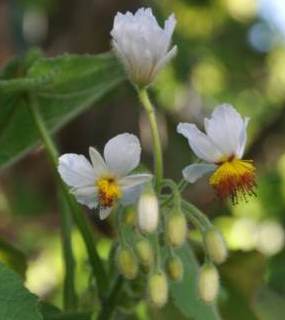
Description
Description
Sparrmannia africana is a large, much branched, bushy soft-wooded evergreen shrub or tree with a rounded habit, usually up to around 4 m but it can reach up to 8 m. The branches are soft, and young branches are covered in stiff, bristly hairs. The leaves are large, up to 270 x 210 mm or more, heart-shaped, with 3, 5, 7 or 9 veins from the base. The margin is toothed. The leaves often have 3, 5, 7 or 9 lobes but are usually entire near the inflorescence. The leaves are softly textured, covered in short, bristly hairs on both sides.
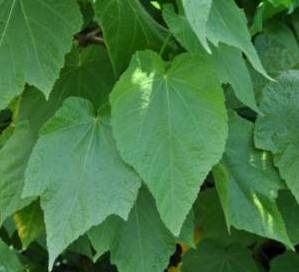
The flowers are white with a mass of yellow and red-purple stamens in the centre, produced in 10-20-flowered umbels towards the ends of the branches. In bud, the flowers are white to greenish white and drooping, and the outer surface of the sepals and the pedicels (flower stalks) are covered in short bristly hairs. The pedicel lifts up to about 45° as the flower opens to release white petals that open wide and then reflex fully, exposing the central mass of stamens. When spent, the petals and sepals close up again and by now the pedicel is standing straight up.
Much of the attraction of this flower is in the puff of brightly bicoloured stamens. Many free stamens form the central mass but not all of them are fertile. The outer stamens are yellow with purple tips and are sterile, while the inner ones, stained reddish-purple with purple tips, are fertile. The filaments are about 10 mm long and are moniliform in the upper half, meaning that they are regularly constricted resulting in bumps or knobs, like a string of beads or a knotted rope. They are also sensitive to touch (see Ecology). Flowering occurs from mid-winter into early summer (June to November).
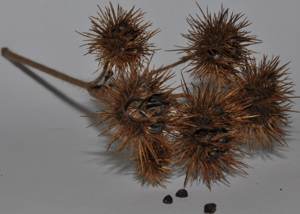
The fruit is a rounded capsule, about 20 mm in diameter, covered in spiny bristles, that splits open when ripe (dehiscent) to release 3 x 2 mm brown seeds with a finely wrinkled (rugulose) seed coat.
Conservation Status
Status
Least Concern. Sparrmannia africana is not threatened.
Distribution and habitat
Distribution description
Sparrmannia africana grows in damp places on forest margins, hill slopes, in ravines, on rocky hillsides and along streams along the southern coast from Riversdale in the Western Cape to Port Elizabeth in the Eastern Cape. It is common in the districts of George, Knysna, Uniondale and Humansdsorp.
Derivation of name and historical aspects
History
The genus Sparrmannia is named in honour of Anders Sparrmann (1748-1820) (sometimes rendered as Andrew or Andreas), Swedish botanist and physician, and pupil of Linnaeus. He was ship's surgeon to Capt. Ekeberg who brought him to Cape Town in 1772. He accompanied Capt. Cook on his second great voyage, 1772-75, returned to Cape Town in 1775 and undertook a journey into the interior of South Africa - travelling as far as the Somerset East area in the Eastern Cape, which is when he must have collected this species - returning to Sweden in 1776.
Sparrmann was the first botanist to collect Sparrmannia africana and introduced it to European horticulture in about 1778 where it was commonly cultivated in conservatories at that time. This species is named for its place of origin, Africa, africana meaning of or from Africa in Latin.
The Malvaceae is a family of about 243 genera and 4225 species, with 31 genera and 401 species native to southern Africa, as well as 8 genera and 20 exotic species that have naturalised. Sparrmannia was previously placed in Tiliaceae, the Jute & Linden family. Today Tiliaceae, Bombacaceae (Bombax, Kapok & Baobab family), Sterculiaceae (Sterculia family) and Malvaceae are all regarded as part of a single family, Malvaceae.
Sparrmannia is a small genus of about seven species native to Africa and Madagascar, with only two species native to southern Africa. The other southern African species is S. ricinocarpa , which is a slender shrub or straggling scrambler found at forest edges or in forest clearings in the Eastern Cape, KwaZulu-Natal, Free State, Lesotho, Gauteng, Mpumalanga and Swaziland into tropical Africa.
The confusion regarding the spelling, Sparmannia vs. Sparrmannia, can be traced back to Carl Linnaeus the younger (L.f.), the son of Carl Linnaeus. In 1782 when he published the name and description of this genus, he misspelled the genus name with one R but in the species description he spelled it correctly with two Rs. Both names were in use, as different botanists adopted one or the other spelling, until 1989 when Codd and Nicolas proposed that Sparrmannia be conserved, as it was clearly Linnaeus's intention to spell it that way, after Anders Sparrmann, and that his use of Sparmannia was an orthographic error.
Ecology
Ecology
The stamens are sensitive to touch. When an insect, or a finger, bumps or brushes the flower the mass of stamens puffs out even further. One can watch as the mass opens itself out, rather like watching a hairy caterpillar puff itself up when threatened. The scientific term for this is haptonasty. In this case it is thought that the movement aids pollination by pushing pollen out and onto the visitor's body.
The knobs on the filaments are thought to mimic 'feeding anthers', and when visitors try to exploit them, they come into contact with the fertile stamens and stigma and effect pollination. Feeding anthers is the term used for the anthers of plants that offer up their anthers or parts of them as bait to pollinating insects, so that visitors eat them and take up and move the pollen incidentally as they are feeding.
According to Mabberley (2008), the reflexed petals of the flower keep the stamens and anthers dry during rain. The cupped petals fill up with water and it overflows gently, a drop at a time.
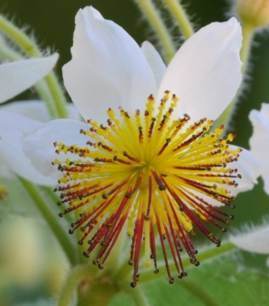
Uses
Use
The timber is soft and spongy and of little value, but the plant yields a good fibre. In 1886 an attempt was made for a few years by the Kama Fibre Syndicate to commercially exploit the fibre at Storms River. It was sold under the name African Hemp. In 1908 and 1919 the Imperial Institute in London investigated the fibre, and found it was inferior to Indian jute; too brittle for the manufacture of rope and twine, and too harsh for mixing with jute.
It is a popular house plant in Europe, where it is known as African Hemp, African Linden or House Lime.
Some people report minor skin irritation when handling the hairy leaves.
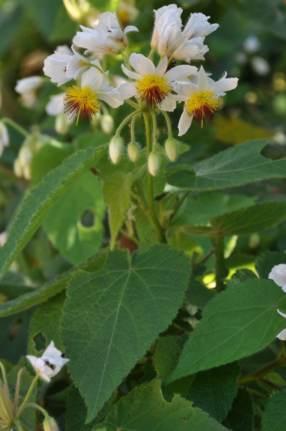
Growing Sparrmannia africana
Grow
Sparrmannia africana is fast and easy to grow. It is well known in cultivation, better known as a house plant in Europe and the USA, than as a garden plant at home.
Grow Sparrmannia africana in half-day shade, semi-shade, dappled shade or light shade. It will grow in a sunny position but this plant prefers a bit of shade. It is not fussy about soils but grows better in well-drained, fertile, well-composted soils. Add compost when planting and lay a generous mulch of compost at least once a year. It is better in a well ventilated position, because free air circulation reduces attacks by fungi on the leaves.
However it is not suited to an exposed position that receives strong wind, especially sustained strong wind like Cape Town's South-Easter. It needs protection from frost, although it will survive and resprout if cut down by light frost. Water well, especially when young, thereafter water moderately. Yellowing of the leaves indicates drought stress. Prune to shape. If left unpruned it can become leggy. Prune back hard once a year, in spring, to encourage a dense, bushy habit.
Sparrmannia africana brings a lush, leafy look to the garden, and is ideal for the shade garden, shady courtyards, the south side of the house that does not see much sun, or use it to screen a shady boundary wall. It is fast growing, and a useful plant to fill an empty space, fast.
Sparrmannia africana does well in pots and can be grown indoors where it needs a well ventilated position in bright light but not direct sun. Water well in summer. Feed generously or repot every year with fresh, composted soil.
Sparrmannia africana is easy to propagate from seed or cuttings. Sow seed in spring or early summer, use a general mix suitable for seedlings and keep warm and moist. Take semi-hardwood or hardwood cuttings in spring or summer, remove at least a third of the leaves and treat with a suitable rooting hormone. At Kirstenbosch we have found that the leaves rot off very quickly if they get too wet. Thus, when cuttings are placed in the mist unit with bottom-heated benches, the misters are reduced to an 8 second burst every 10-12 minutes. Alternatively, the cuttings can be rooted in a cold frame.
References
- Biodiversity Explorer: http://www.biodiversityexplorer.org, Family: Malvaceae http://www.biodiversityexplorer.org/plants/malvaceae/index.htm, accessed 5 March 2013
- Coates Palgrave, K. 1983. Trees of Southern Africa , second revised edition . Struik Publishers, Cape Town.
- Codd, L.E. & Nichols, A. 1989. Proposal to conserve the spelling Sparrmannia L. f. against Sparmannia L. f. (Tiliaceae). Taxon 38 (4): 669-670.
- Foden, W. & Potter, L. 2005. Sparrmannia africana L.f. National Assessment: Red List of South African Plants version 2013.1. Accessed on 2013/03/05
- Goldblatt, P. & Manning, J.C. 2000. Cape plants. A conspectus of the Cape Flora of South Africa. Strelitzia 9. National Botanical Institute, Pretoria & Missouri Botanical Garden Press, Missouri.
- Jackson, W.P.U. 1990. Origins and meanings of names of South African plant genera . U.C.T. Printing Dept., Cape Town.
- Killick, D.J.B. 1973. Flowering Plants of Africa 42: t. 1663.
- Kubitzki, K. & Bayer, C. 2003. The families and genera of vascular plants -- Dicotyledons 5. Malvales, Capparales and Non -betalain Caryophyllales. Springer-Verlag, Berlin.
- Leistner, O.A. (ed.). 2000. Seed plants of southern Africa: families and genera. Strelitzia 10. National Botanical Institute, Pretoria.
- Mabberley, D.J. 2008. Mabberley's Plant-book: A portable dictionary of plants, their classification and uses , edn 3. Cambridge University Press.
- Palmer, E. & Pitman, N. 1972. Trees of Southern Africa . A.A. Balkema, Cape Town.
- Plants of southern Africa online (POSA) http://posa.sanbi.org accessed 5 March 2013
- Smith, C.A. 1966. Common names of South African plants. Memoirs of the Botanical Survey of South Africa No. 35.
- Wild, H. 1984. Flora of southern Africa 21(1) Tiliaceae. Botanical Research Institute, Dept of Agriculture, Pretoria.
Credits
Alice Notten
Kirstenbosch NBG
April 2013
Plant Attributes:
Plant Type: Shrub
SA Distribution: Eastern Cape, Western Cape
Soil type: Sandy
Flowering season: Spring, Early Summer, Winter
PH:
Flower colour: Red, White, Yellow
Aspect: Shade, Morning Sun (Semi Shade), Afternoon Sun (Semi Shade)
Gardening skill: Easy
Special Features:
Horticultural zones
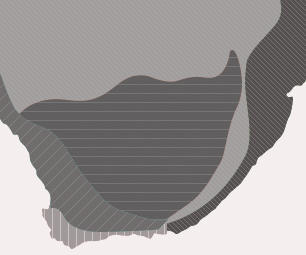









Rate this article
Article well written and informative
Rate this plant
Is this an interesting plant?
Login to add your Comment
Back to topNot registered yet? Click here to register.